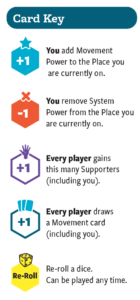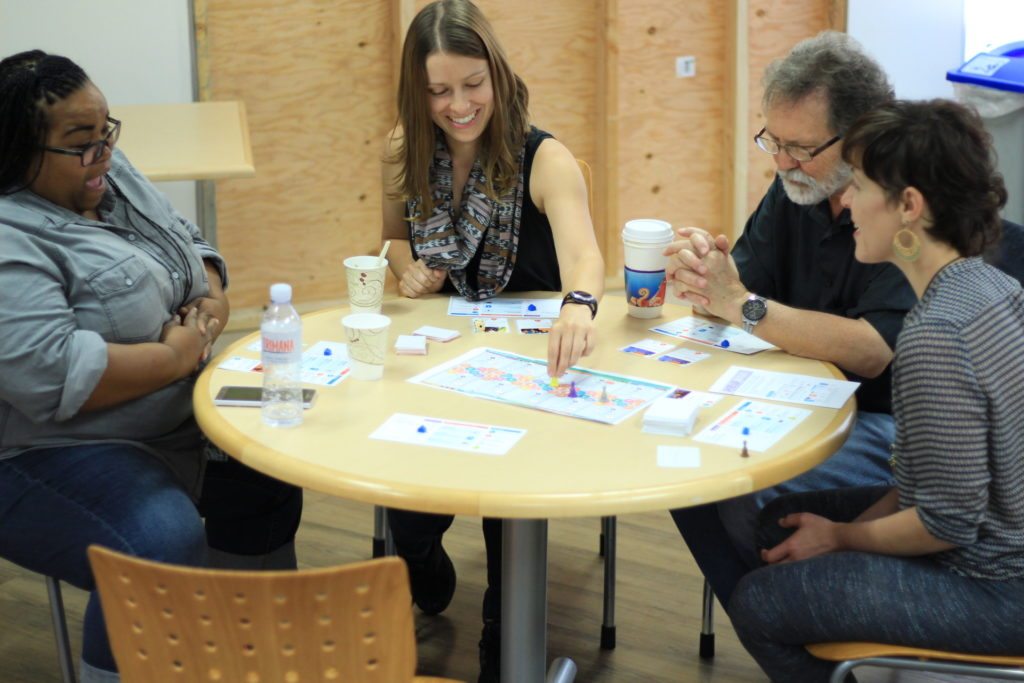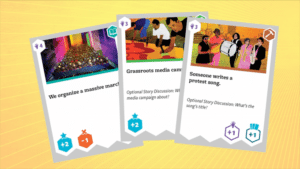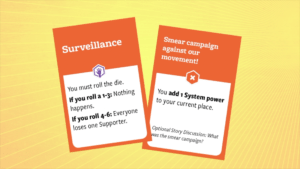A couple years ago, I was fortunate enough to land a volunteer service position at a social justice focused school. Rather than being taboo topics as they would be at other schools, we talked openly with our students about issues of racism, homophobia, and environmental justice and encouraged them to complete projects about the injustices that affected their lives. Adults and young people alike come alive when they find a way to fight against the oppression in their lives, and nothing is more exciting than enabling them to do so. This kind of empowerment is the impetus behind Rise Up: The Game of People and Power; a board game currently being funded on kickstarter.

Rise Up is a cooperative board game in which players strategize, organize, and engage all their creativity to create change and fight oppression. While the game was initially devised by TESA, a gaming cooperative invested in social justice, an incredible team of collaborators have brought Rise Up into existence. Graphic designer Molly Mcleod, Design Action Collective, a worker-owned graphic design and visual communications studio, and Community Printers, a worker-owned cooperative printer, have joined forces to produce this unique and engaging game. I spoke with Brian Van Slyke, the Project Lead and Lead Game Designer for Rise Up, about social justice education, the research and inspiration behind the game, and why having fun is the most important part of the process.
What first inspired you to create Rise Up?
My organization, the TESA collective, had previously created Co-opoly: The Game of Cooperatives. When it was still a prototype we were invited to take Co-opoly to New York City to this event. We were playing it at the event and then some people invited us to bring it to this protest that was happening. We brought it over there and we got to meet a lot of people, it was very cool. It was a little protest at the time but later got much bigger; [it became] Occupy Wall Street!
Right after we left there were some raids against Occupy Wall Street that cleared out the camp. Then folks came back and started doing more organizing and we were like, we should build a game that celebrates people building these movements. There’s been a lot more movements springing up; Black Lives Matter, Fight for 15, fights against deportations, that kind of stuff, and we were just kind of like, let’s actually do this.
It’s awesome to live in a time when there are so many movements, but heartbreaking for the reasons they have to exist. We wanted to build a game that both celebrated those movements but also explored them.
To create the options players have but also the obstacles they face, did you look at specific movements?
We did a lot of research on movement tactics; both things that happen through organizing and things that happen spontaneously. We focused on modern more because we wanted it to be a game about modern movements and people coming up with their own ideas for modern movements. Some of the research about how systems respond is steeped more in historical stuff.

If your goal is to educate people about fighting oppression, why the board game format?
There’s lots of great, amazing tools and programs and articles and PowerPoints and stuff out there, but we really wanted to offer people a way to engage through play, participation, and dialog. While Rise Up is a fun board game first and foremost, we also see it as a great social justice education tool that will allow people who are experienced activists to play with their ideas figuratively, but also will get people who have no experience to imagine themselves as the person writing the protest song or leading the march. The game is really about activating imaginations and dialoguing about how would we build this movement, [and] why. It’s a game with a lot of serious elements, but we try to provide levity. At the start of each game you come up with a movement. It could be a real thing like Fight for 15 or something totally fake.
Like in the kickstarter, it’s free pizza for all?
Yes! I love that one. That gives people who aren’t as engaged with the concepts a chance to come at it from a place that’s more playful, and lets them let their guard down. As a former educator the educational side of it interests me, especially the education kit. What does the kit specifically offer? The education kit is really meant to make it so that people can dive into the concepts deeper. For people who want to use it to facilitate a workshop or a class, it’ll come with a workshop that introduces concepts about movement building. There’s stuff that’s plug-and-play, so you can easily use it in your classroom or wherever. There’s some interactive worksheets so that people can be like OK, now that I played this game, these tactics spoke to me, or this is a movement I would want to build.
The game also comes with two sets of rules: a simplified [set] and a more in-depth version. The simplified version is meant to be the more educational version and will plug into the education kit really well. It’ll have these workshops that, if you’re a facilitator who has a lot of experience running workshops, you can easily run, but also it’ll be easily laid out so if you don’t, it’ll be really easy to run.
Even if you are an educator who is used to running workshops, sometimes you’re just busy!
Yes! Totally. The point is to make it as easy for people as possible. There are some parts that are very moduled, so it doesn’t have to be part of a curriculum that goes from A to B. So, let’s say you just want to play the game and have a discussion afterwards. Here’s like fifteen questions that can guide that conversation.

How do you take into consideration people who are not as into games, who would be potentially overwhelmed?
That’s [also] why we have this double-sided board. We had to work with both our graphic designer and the manufacturer to make this possible, but the game comes with the standard version for people who are ready to dive into deep stuff. People who are not very familiar with it can flip they board over, and they have a simpler version.
So simpler in game play, but not simpler in content?
Yes, the simplified version is a roll and move game. You roll the dice, you move across the board, you land on a space. It might be a space that’s good for your movement, it might be something that’s bad, like the system gains power. But then you decide to do one thing: you organize to gain a supporter, you can educate, which means you draw a movement card, or you agitate, which means you play a movement card. All the movement cards have one or two symbols which will either let you add movement power to the place you’re on -so if you’re on internet you would add movement power to internet – or take away system power. It’s a cooperative game so you’re trying to help everyone; if you play [an organize] card everyone gains a supporter. You can help everyone organize and help everyone educate.
Are the agitate cards all non-violent?
They’re all non-violent. The “agitate” is a little bit of a misnomer; some of it is like “write a protest song” or “spend all day gathering support;” “educate, organize, agitate” is just an easy reference. In original versions we had direct actions and stuff like that, [but] we had educators tell us they wouldn’t necessarily feel comfortable using something in the classroom that puts people in danger. There are things that skirt the line, like civil disobedience and sit-ins, pickets, which aren’t always legal, or taking over a public space. With the system’s reaction, [things like] police misconduct can happen.
That’s the simplified side. The standard version is a little more the complexity of Settlers of Catan or Pandemic. On your turn, you can do anything in any amount of order. You do a lot of combing, people build off each other, [you can] start a chain of events. I can play a card that says, like, “grassroots media campaign,” and you might have a card that has the same symbol, so you can play off of that.
As you play, you move along your piece. On [the standard version] it’s open-ended, so you can be like, OK, we’re losing power in workplaces. I’m gonna move this to workplaces to try to play this card; that takes the system down. It’s a lot more freeform; [there’s more] strategizing. [The simplified] version is still fun, and one advantage of it is that it’s more fast-paced because you make one decision and the next player goes. If you land on the spaces with the x’s, you draw system cards.

How do you win?
You’re trying to gain movement power, the system’s trying to gain power. If either the movement or the system gets to four power in a place, you gain a victory there. Your movement has to gain more victories than the system does. Also, everyone loses if any single person runs out of supporters. The system can defeat you by gaining too much power or depleting you of supporters, and the only way your movement can win is if you get enough power across the board.
How have the reactions been from those who have played it?
It’s been great. It was really intentional to have play tests with both activists who don’t really play games at all and game players who aren’t really involved in activism at all, and then people who are on that Venn diagram in the middle. Our youngest play tester was nine years old. At one point he shouted “I want to organize!” which is the most adorable thing that’s ever happened.
The game testing was really trying to make sure that it’s a fun game first and that it does emulate movement building, but not in an educational way that’s hitting you over the head, like, learn now! This is movement building! We had one play tester who’s the Associate Director of the Midwest Academy here in Chicago who was like, this is great, it’s fun, it’s totally engaging, it sucks you in and it completely mirrors what it’s like to actually build a movement and how you have to collaborate to do it. We also wanted people who’d never been involved in activism before to get sucked in by the game play and the storytelling, and think about the movement building aspect afterwards.
Do you have specific advice for people who do want to use the game in educational settings?
I think the best way that the game can be used is in a way that encourages people to play and have fun and laughter, and to allow them to joke around and experiment and fail. That’s one of the things that I think games can do and that I feel really strongly about in social justice education: fail is not a four letter word. It’s OK to take chances, lose, and then try again. What we really want with the game is to say, OK your movement lost? Let’s try again! To encourage that dialog and to encourage people to have deviations. A lot of times when you do workshops you see people like, well you’re getting away from the main thing, we need to do the activity. They’re actually having a really interesting conversation about movement building; let them have that conversation. Encourage the natural learning that comes out of the game.

What does ethical manufacturing mean for Rise Up?
We had previous experience with Co-opoly trying ethical manufacturing, and at the time, it was the most ethically manufactured game. It was 70% produced by worker-owned cooperatives, [which are] businesses that are democratically owned and managed by the people who work there. So, each person has one equal share in the business and one governance vote. They’re awesome tools for economic empowerment; they’re doing a lot of great work.
With Co-opoly we had a few different worker cooperatives doing print work and then we had a US printer that wasn’t a worker co-op print the board and the box. The worker cooperatives printed all the cards, the instructions, and all the components. While that was really important to us and we were really proud, it cost a lot of money to do that across three manufacturers. We still assemble and ship out each game of Co-opoly, which is a lot of work.
We wanted to streamline it but also go all-in and see if we could make it completely with a worker-owned cooperative. We found this group, Community Printers, in California, which is a worker-owned union shop. We worked with them for about five months to figure out a process for building the board, the box, and all the components, and to make it at least reasonably affordable. A lot of indie games keep the cost up to 70 or 80 bucks and we wanted to make it as accessible as possible. We’ve already recommended another board game producer use the format that we set up, so it’s already having this effect where there’s another board game that’s going to be produced in this fashion.
As much as possible we’re using sustainably sourced and recycled materials. Community Printers has a great history of this; they know the suppliers and they’re able to make it happen. The only part that is coming from out of the US is the dice, which are coming from Denmark. The vast majority of dice produced in the board game world come from sweatshops, and with Co-opoly we had found the last remaining US producer of dice, but they have since stopped producing, unfortunately. We had this month-long investigation to finally find a producer who produced in OK conditions.

Rise Up’s stretch goals include expansion packs. Tell me about those, especially Secret Agendas!
We wanted to make Rise Up into a game people would play over and over again. While we feel Rise Up is in itself great, we had too much fun coming up with new ideas. We came up with Secret Agendas to be a semi-cooperative game; some people can win and some people can lose. [It] gets into the part of movement building where maybe you have a funder who really doesn’t want you to do anything against the government; I may have a big business funder, so my secret agenda is the system has to win a victory in workplaces, and maybe your secret agenda is directly against that. Or maybe I’m someone who’s not ready for the movement to win and I want the system to win.
Semi-cooperative games are having a bit of a field day, like Dead of Winter and that kind of stuff. It’s the version for people who maybe aren’t ready to go full in on cooperative, or want to spice up the cooperative.
Is it like Clue, where you can’t reveal your secret until the end? So you can’t come out of it and compromise?
Exactly. At the end, I reveal that I had a big business backer, or maybe if my secret agenda was for the system to win and everyone’s like, oh, we all lose, then I flip over and I’m like, oh, but I won! It’s not the main version of the game for a reason.
Of our stretch goals, the biggest one that we really want to do more than anything is to translate the game into Spanish. That’s our furthest because it’s gonna take so much time and basically double our production costs. We really want to not just translate the game but work with folks who do organizing in Spanish communities who can say these are our tactics and this is language that we feel is important to include. If we don’t hit it we’re still committed to doing that, it’s just that it may take more time.
Do you have collaborators in mind for the Spanish version?
Yes, we’ve previously translated Co-opoly to Spanish. We’ve had this whole volunteer system where we worked with volunteers all over the place and translated it. We might do that, but if we’re able to raise enough money for the kickstarter [to find] a translation cooperative [we’ll] do that. We’ve had partners and people we’ve worked with, but if we’re able to raise enough money we might really streamline it.
To help TESA translate this incredible game into Spanish, and to get a board for yourself, check out the Rise Up kickstarter. Hurry — this is their final week!

